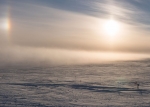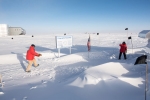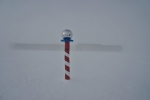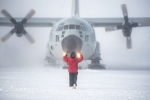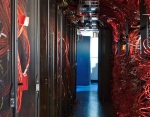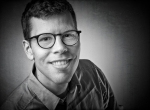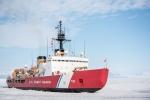The fifth edition of the IceCube Masterclass hosted over 300 students at 17 institutions in Belgium, Denmark, Germany, Switzerland, and the United States.
It takes a long time for the sun to set at the South Pole. Maybe just as well for last week. It allowed IceCube’s winterovers to continue taking outdoor photographs of the landscape, and it gave them some light to see what they were doing while out in the field, driving around and measuring the snow height at all the IceTop stations.
The fuel arch under the station is one of the coldest—and creepiest—places at the Pole, accessed from a network of underground ice tunnels. The tunnels maintain an even temperature of around -50 °C at all times.
A quiet week at the Pole. And when the quiet stems from a well-behaved detector, there’s nothing to complain about. IceCube winterover Johannes and others took advantage of the remaining daylight to get in some Frisbee while they still can.
That’s it—the South Pole station is officially closed for the season. The few remaining summer people have departed on the last plane out, which brought to the Pole a nice supply of “freshies,” as they like to refer to their perishable produce.
It was a busy week at the Pole. There are always lots of preparations to be made before hunkering down for the many months of isolation and darkness. With the busy airfield, IceCube winterover Raffaela was out helping park a Herc.
At WIPAC, Juan Carlos Díaz-Vélez leads the simulation production for IceCube, but he has also been busy as a PhD candidate of the Universidad de Guadalajara in Mexico. Yesterday, the Centro Universitario de los Valles (CUVALLES) in Guadalajara awarded him the best post-graduate thesis in 2017, acknowledging his contributions to the study of cosmic rays with HAWC and IceCube.
The summer season is nearing its end. So IceCube’s winterovers were busy helping summer crew wrap up their tasks. That included some cleaning and recabling in the ICL.
After a five-year John Bahcall postdoctoral fellowship at WIPAC, astroparticle physicist Markus Ahlers returned to Europe in February 2017. Currently an assistant professor in the Theoretical Particle Physics and Cosmology research group at the Niels Bohr Institute in Copenhagen, Markus is now enjoying one of those dreams come true: the birth of his own research team. A Villum Young Investigator grant for 7.350.000 DDK ($1.2 million), which he was formally awarded on January 23, has secured the foundation of a new research group.
IceCube winterover Raffaela got to see some amazing wildlife on her break, but check out what Johannes spotted on his R&R trip to McMurdo. That’s an icebreaker, which is needed to cut channels through the thick sea ice to allow fuel and cargo vessels to reach McMurdo Station.


